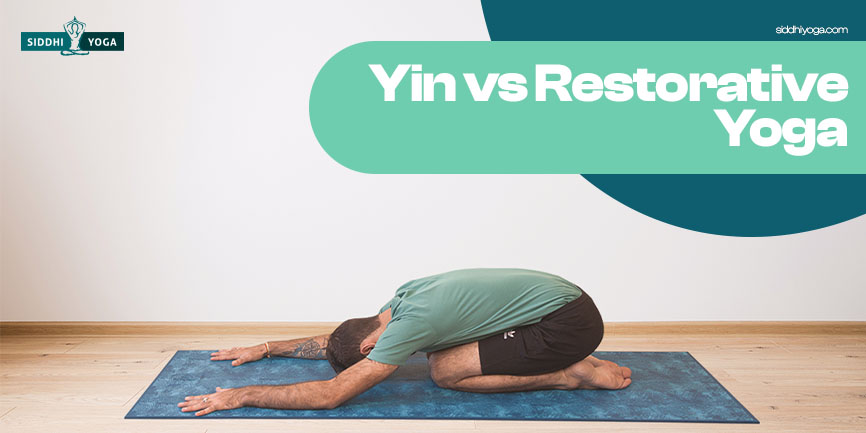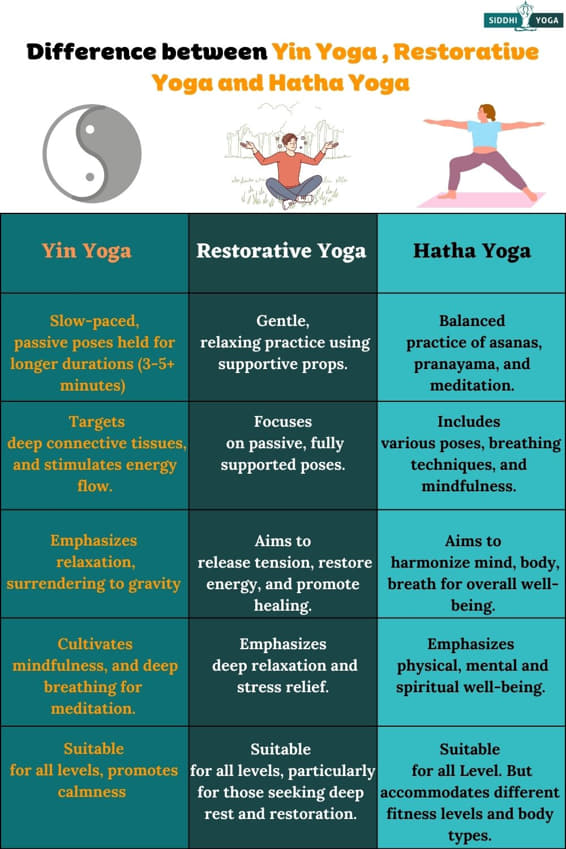
Read about the history and origins of Yin Yoga, comparisons of Yin Yoga versus Restorative, Hatha and other yoga types, and principles and practice differences of Yin Yoga.
Introduction
As life’s pace increases worldwide, stress, exhaustion and burnout have become common. Getting back on your feet after burnout can be lengthy and tedious. Yin Yoga can help centre and ground you and help you access an oasis of peace in the crazy world around you. It is an effective antidote to stress.
Yin Yoga, its History and Origins
Yin Yoga traces its origins to ancient Chinese Taoist practices such as Tao Yin or Taoist Yoga. Believed to be over 6,000 years old, Tao Yin practices have been a part of Kung Fu training for an equally long period of time. The Chinese system of energy meridians is also an important foundational concept of the style.
Yin Yoga stretches have always been a part of Hatha Yoga practices and many schools teach students to hold poses for a longer duration, which is one of the basic concepts of Yin Yoga. However, the focus was more on yang poses and Yin Yoga asanas were relegated to the background.
Two teachers of yoga are credited with restoring balance and bringing Yin Yoga stretches back to the fore — Paul Grilley and Sarah Powers. Paul Grilley attended Paulie Zink’s Taoist Yoga classes in the late 1980s and was intrigued by the long-held poses. He realized that they trained the body for long meditative sessions.
Paul Grilley started conducting classes teaching stretches held for extended durations, and Sarah Powers coined the term ‘Yin Yoga’ to differentiate the style from other forms of yoga. Yin Yoga is founded on an open-sourced model and is constantly evolving.
See Also: Renew Yoga Teacher Training Online
Takeaway
Yin Yoga is a relatively new style of yoga, but with an illustrious history that can be traced back to ancient Hatha Yoga and Taoist practices.
Yin Yoga is Unique — Here’s How
Yin Yoga is a slow style of yoga done either lying down or seated. Unlike other forms of yoga, you do not strain or force yourself to achieve a pose. A key element of the style is maintaining a pose for longer, which helps the mind transition from active busyness to passive peace. The long hold times for poses also give ample time to lengthen the plastic connective tissue they stimulate.
Focussing on the following unique aspects of Yin Yoga practice is integral to achieving perfection in a stretch.
- Once you come into a pose, wait till your body opens up and asks you to delve deeper. Then, go in deep into a stretch until you experience mild discomfort. If you experience pain or severe discomfort, release the pose. Listen to your body to know your limits.
- When you settle into a pose, let go of movement other than your gently flowing breath. Try to remain still — still in mind and body.
- After you find the edge and achieve stillness, stay in the pose for the maximum time possible. Do not exceed your limits and allow your body to experience severe pain or discomfort. Yin Yoga stretches can be held anywhere between 1-5 minutes.
- Enter and exit the poses slowly — and with awareness. Release each pose gently as the area that underwent the stretch will feel fragile immediately after doing them.
In some instances, Yin Yoga may not be your perfect yoga practice choice. For example, if you already are a yin person — passive, calm and docile — taking up Yin Yoga practice may entrench you in the tendency to over-analyze and become inert, stagnate or even get into depression. For such people, Yang Yoga may be the better choice.
Joint injuries can cause hypermobility with damage to the restraining connective tissue around it. In such cases, a Yang Yoga style that strengthens the joints and tissues should be adopted, not one that lengthens it. Also, if you are aiming for a cardio workout and body strengthening routine, consider Yang Yoga instead.
Takeaway
The gentle and slow pace of Yin Yoga is a therapeutic process that helps you release the stress stored deep in the body and mind.
Yin Yoga vs Restorative Yoga

When you compare Yin Yoga to Restorative Yoga, you realize they are very similar. Both forms promote relaxation by stimulating the parasympathetic nervous system. They help you connect to your body, calm your mind and cultivate inner awareness. Both practices are gentle and suitable for all ages and levels. Despite the similarities, the Yin Yoga versus Restorative Yoga comparison also shows that they have dissimilarities.
If you have an injury or health problems, Restorative Yoga would be the better option for you. Restorative yoga supports the healing process of the body, revitalizes it and helps to bring it back to optimum health. On the other hand, Yin Yoga works deep into the connective tissues to release fascia and increase flexibility. It helps enhance the performance of an already healthy body.
Yin Yoga advocates an active stretch, while in Restorative Yoga a pose is fully supported and passive. Both styles use props. However, in Yin Yoga, you use a prop to deepen a pose or come into better alignment, while in Restorative Yoga props are used to completely support your body when performing a pose. Restorative Yoga practitioners tend to use more props than Yin Yoga students.
Takeaway
Yin Yoga releases deep fascia and connective tissue to improve flexibility in an already healthy body, while Restorative Yoga helps an injured or ill body to heal.
Yin Yoga vs Vinyasa Yoga
When you compare Yin Yoga to Vinyasa Yoga, you realize they are very different. Vinyasa Yoga is an active style of yoga, the robustness of which can raise the heartbeat and work up a good sweat during a session. It is dynamic, repetitive, strengthening, and can be a good workout; whereas Yin Yoga is a gentle practice that helps you calm down and relax. It releases stress buried deep in the fascia and lengthens it, improving flexibility and overall mobility.
Vinyasa Yoga flows quickly from one pose to another, while Yin Yoga poses are held for long durations to become meditative sessions. Yin Yoga comprises supine and seated poses, while Vinyasa Yoga includes standing poses.
Breath plays an important role in Vinyasa Yoga. You flow from one pose to another using the breath as an anchor. Each movement is timed with inhalation or exhalation. In Yin Yoga, you breathe normally throughout the practice, focusing on abdominal breathing.
Takeaway
Vinyasa Yoga is a vigorous style that can prove to be a good physical workout, while Yin Yoga sessions are meditative and can be a prelude to advanced meditation.
Yin Yoga vs Hatha Yoga
Hatha Yoga is a balanced all-around practice that is slower-paced than Vinyasa Yoga. It is the mother lode of all other styles of yoga and provides a blueprint for them. Yin Yoga can be considered an offshoot of Hatha Yoga.
When it comes to Yin Yoga versus Hatha Yoga poses, Yin Yoga stretches are mostly done seated or supine and include only poses. Hatha Yoga has a wider array of exercises, including postures, breathing and cleansing techniques, hand and body gestures, and meditative practices. It includes supine, standing, seated, twisted and inverted poses.
The ‘Ha’ in Hatha Yoga symbolizes the sun or yang energy, while the ‘tha’ represents the moon or yin energy in practice. Hatha Yoga includes both yang and yin poses. On the other hand, Yin Yoga is gentler, slower and more meditative in style. It focuses on the energy meridians in the body and removes blockages or stagnation of energy around vital organs to improve their functioning.
Takeaway
Hatha Yoga is largely seen as the “mother” of all the other forms of yoga, and that includes both yin and yang poses. Yin Yoga focuses exclusively on yin stretches.
Practice Differences of Yin Yoga
Yin Yoga is a relatively slow and simple style of yoga compared to the other forms; however, it is not an easy practice. It requires patience and physical and mental stamina. It is about surrendering, acknowledging, accepting and letting go.
As you surrender to a pose and hold it for long, you become mindful of deep-rooted sensations and emotions that rise to the surface. You become an equanimous witness. Simply acknowledge, accept and let go of whatever comes to the surface — neither attracted nor repulsed by the pleasure or pain of each. Gradually, you will understand that nothing lasts and impermanence is but a part of life.
A Yin Yoga session encourages you to be open to your individual experience. You are free to explore the posture in relation to your body. As opposed to many other yoga systems, you adjust the posture to your body rather than the other way around.
While most yoga styles put pressure on the muscles, Yin Yoga relaxes the muscles involved and focuses on the deep connective tissue. It gently stretches and lengthens fascia, ligaments and tendons to enable an optimum range of motion in our joints. Connective tissue responds best to slow, steady stress created by long-held poses. When you hold a yin pose for a long time, the body responds by making tissues longer and stronger.
A concept unique to Yin Yoga is its connection to energy meridians. The postures activate energy meridians that run throughout our body. An imbalance or blockage in the flow in these channels affects our health. Yin Yoga postures remove blockages and restore smooth flow. This, in turn, can resolve the stagnation of vital energy in and around the organs connected to the meridians and the physical and emotional issues that arise.
Takeaway
Yin Yoga impacts you on a physical, mental, psychological and energy level and aids in your spiritual development.
The Bottomline
Choose a yoga practice that you feel best suits you to achieve peace and calm in a busy world. It should equip you to better understand your mind and body and improve your physical and mental health. Be sure to communicate your concerns about your overall health and physical capabilities with your teacher before joining a course so that you can benefit from a routine tailored to you.
You can learn our online yin yoga course from here